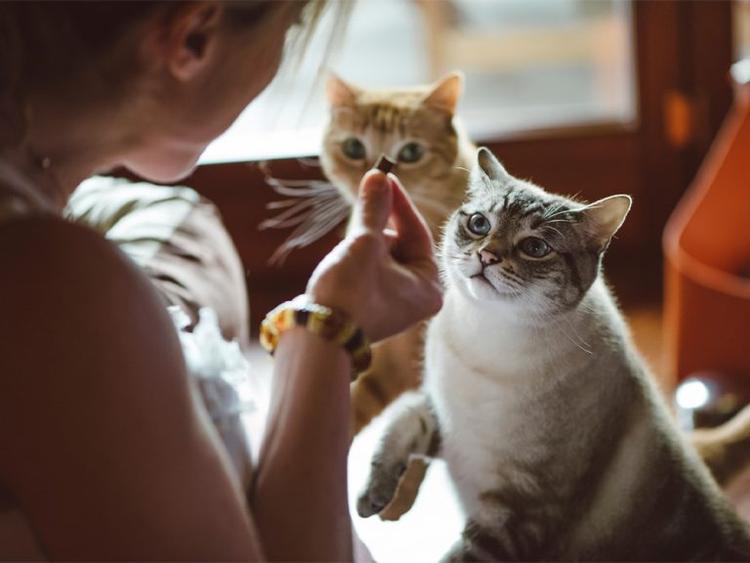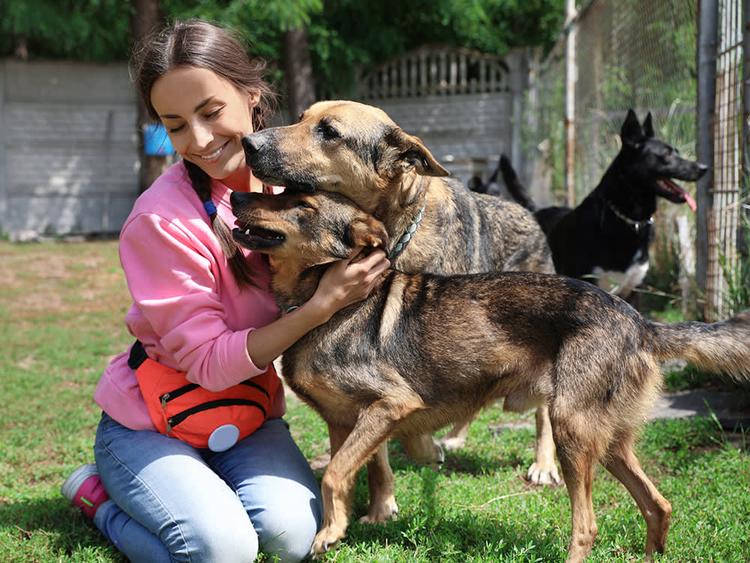Bunny vs. Rabbit: What’s the Difference?
Yes, there is a difference. Read on for everything you’ll ever need to know to distinguish one from the other.
Yes, there is a difference. Read on for everything you’ll ever need to know to distinguish one from the other.
by Adrienne A. Kruzer, BBA, RVT, LVT, | May 14, 2024

Cottonbro studio / Pexels
If you’re wondering what the difference between a bunny and a rabbit is, you’re not alone. “Bunny” is a term often used informally to refer to young rabbits, emphasizing their cute and playful nature. “Rabbit” typically denotes a mature member of the species, recognized for their diverse breeds and roles as pets, companions, or even livestock. While both terms can be interchangeable colloquially, they technically signify different life stages of the same animal. Here’s a guide to using the proper terminology when referring to these fluffy pets.
No, bunnies and rabbits are the same animal, but “bunny” and “rabbit” are technically words used to identify rabbits at different life stages. Despite this technicality, the word “bunny” is regularly used as a nickname, especially by children, for any age of rabbit. The words are often used interchangeably, even if it’s not the proper usage.
A rabbit is a furry mammal with long ears, powerful hind legs, and a fluffy tail resembling a cotton ball. There are both domesticated and wild rabbits. Domesticated rabbit breeds are found in homes worldwide as pets, and on farms where they are raised for food. They originate from the species Oryctolagus cuniculus, a European rabbit.
A bunny is technically a young rabbit. It is also widely acceptable to refer to a larger or adult rabbit as a “bunny” (or “bunny rabbit”), especially for children. This is why some people may say “Easter bunny” and others may say “Easter rabbit” — both are correct. Many rabbit parents also use the word “bunny” as a term of endearment for their mature rabbits, further blurring the proper distinction between the words “bunny” and “rabbit.”
Both domestic and wild rabbits may be lovingly referred to as “bunnies” their entire lives. Domestic rabbits usually live between five and 10 years of age, but one pet rabbit reportedly lived to be 18 years old. Wild rabbits usually live about nine years.

Tima Miroshnichenko / Pexels/ Bunny
So you now know what bunnies and rabbits are. But what is the difference between a bunny, a rabbit, and a hare? While these animals are all part of the same family (Leporidae), they are not all the same species — wild rabbits are from the genus Sylvilagus.
Hares are part of a different scientific genera than domestic rabbits and bunnies. Hares, also known as jackrabbits, are part of the genus Lepus, not Lagomorpha like their rabbit relatives. Hares also have longer ears than most rabbits and 48 chromosomes, whereas rabbits only have 44. Despite this, domestic rabbits, wild rabbits, and hares may all be affectionately referred to as bunnies.
There are domestic rabbits and bunnies, wild rabbits and bunnies, and hares. And there are specific breeds to further differentiate between wild and domestic, and rabbit and hare.
There are several kinds of wild rabbits, but most are considered Cottontail rabbits. Wild Cottontail rabbits are part of the genus Sylvilagus and include the following breeds you may see running around outside, in various parts of the world:
Swamp rabbit (Sylvilagus aquaticus)
Desert Cottontail rabbit (Sylvilagus audubonii)
Brush rabbit (Sylvilagus bachmani)
Forest rabbit (Sylvilagus brasiliensis)
Mexican Cottontail rabbit (Sylvilagus cunicularis)
Dice’s Cottontail rabbit (Sylvilagus dicei)
Eastern Cottontail rabbit (Sylvilagus floridanus)
Tres Marias rabbit (Sylvilagus graysoni)
Omilteme Cottontail rabbit (Sylvilagus insonus)
San Jose Brush rabbit (Sylvilagus mansuetus)
Mountain Cottontail rabbit (Sylvilagus nuttallii)
Marsh rabbit (Sylvilagus palustris)
New England Cottontail rabbit (Sylvilagus transitionalis)
The following other breeds of wild rabbits also exist but are not of the Sylvilagus genus:
Pygmy rabbit (Brachylagus idahoensis)
Bushman rabbit (Bunolagus monticularis)
Sumatran Striped rabbit (Nesolagus netscheri)
Annamite Striped rabbit (Nesolagus timminsi)
European rabbit (Oryctolagus cuniculus)
Amami rabbit/Ryūkyū rabbit (Pentalagus furnessi)
Central African rabbit (Poelagus marjorita)
Volcano rabbit (Romerolagus diazi)
Finally, when it comes to domestic rabbits, they all have the same scientific name as the European rabbit, Oryctolagus cuniculus. But there are over 300 different breeds of domesticated rabbits around the world. These domestic-rabbit breeds can look vastly different from one another with variations in colors, fur length and texture, size, body conformation, and even their ears. Some of the more commonly seen breeds of domestic rabbits include:
Flemish Giant rabbit
Checkered Giant rabbit
Cinnamon rabbit
Angora rabbit
American Sable rabbit
American rabbit
Netherland Dwarf rabbit
California White rabbit (aka The Californian)
Holland Lop rabbit
Rex rabbit
Lionhead rabbit
Dutch rabbit
English Lop rabbit
Mini Lop rabbit
French Lop rabbit
Mini Rex rabbit
English Spot rabbit
Harlequin rabbit
New Zealand rabbit
American Fuzzy Lop rabbit
Jersey Wooly rabbit
Dwarf Hotot rabbit
Mini Satin rabbit
American Chinchilla rabbit

Elizabeth Iris / Pexels/ Hare
You already know that hares are different from rabbits. However, did you know that there are more than 30 different breeds of hares (or jackrabbits), and all of them belong to the genus Lepus? Hares are fast and sometimes hard to catch a glimpse of. But if you get a good look at them, you’ll see that they all look slightly different. Some of the more common hare breeds around the world include:
Antelope jackrabbit (Lepus alleni)
Snowshoe hare (Lepus americanus)
Arctic hare (Lepus arcticus)
Alaskan hare (Lepus othus)
Mountain hare (Lepus timidus)
Black jackrabbit (Lepus insularis)
Desert hare (Lepus tibetanus)
European hare (Lepus europaeus)
African Savanna hare (Lepus victoriae)
Black-Tailed jackrabbit (Lepus californicus)
White-Sided jackrabbit (Lepus callotis)
White-Tailed jackrabbit (Lepus townsendii)
While baby rabbits are often referred to as “bunnies,” the technical term is actually “kit.” The word “kit” is derived from the word “kitten,” although this longer term is not commonly used. When a rabbit gives birth, the birthing process is referred to as “kindling” (a litter of up to 15 kits can be born during a kindling). All kits are born without fur, and with their eyes and ears shut. Similar to puppies and kittens, as kits grow, they develop fur as well as the ability to see and hear. At about six to eight weeks of age, a kit can leave their mother and survive on their own, so you won’t find a bunny for sale or adoption who is any younger than six weeks of age.
Going back, countless English words are derived from other languages. Both “bunny” and “rabbit” have been used to describe these long-eared animals for centuries, so where did these terms originally come from?
The word evolved from the English word “bun” to “bunny” in the 17th century, and was originally used as a term of endearment between two people. Eventually, it began to be used to refer to a squirrel or a rabbit. Over time, “bunny” became an endearing term for a young rabbit. Some rabbit breeds stay small and cute their entire lives, so it’s natural that they’d be called“bunnies.” It also seemed more appropriate to refer to the Easter bunny, an iconic children’s holiday character who brings colorful eggs, as a “bunny” instead of a “rabbit” due to their cute factor.
The word “rabbit” dates back to the 14th century. It likely evolved from various other words, including the Dutch robbe or robbeken, the Middle French robett, and the Middle English rabet. When you say these words out loud, it’s not hard to hear how we derived the word “rabbit” from these other languages.
Rabbits have been used as both food and companionship for centuries, but no one knows for sure when they were domesticated. Regardless, we do know that rabbits (or bunnies) are popular pets around the world.
The History of Domestication: A Rabbit’s Tale
Studies in Mammalian Spermatogenesis VI. The Chromosomes of the Rabbit

Adrienne Kruzer is an accomplished veterinary technician and writer with over 15 years of hands-on experience caring for domestic and exotic animals.

Adoption Advice

Adoption Advice

Adoption Advice

Adoption Advice

Shelters & Rescue

Shelters & Rescue

Adoption Advice


Adoption Advice
Thinking of adopting a dog with kids? Read more to learn about the benefits pets can have on children.